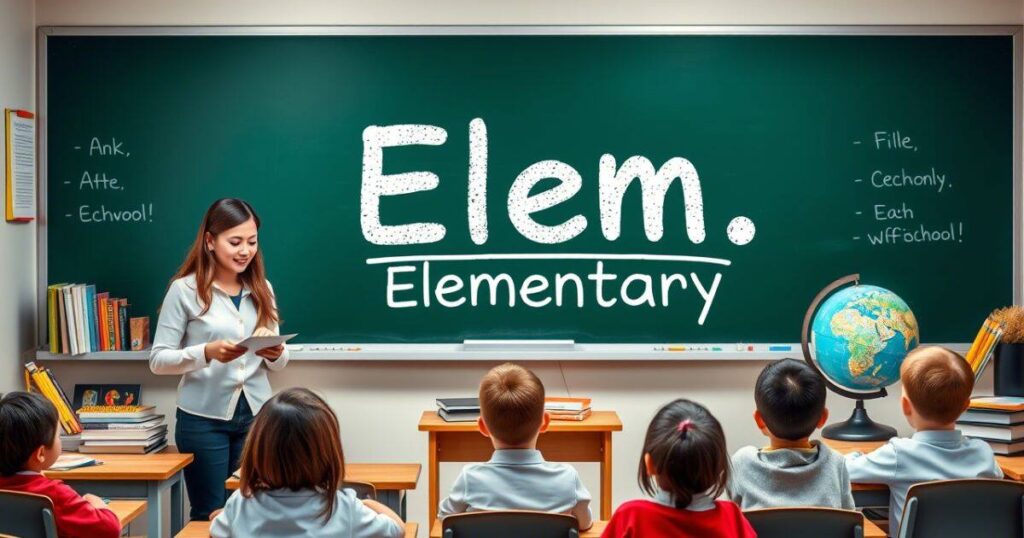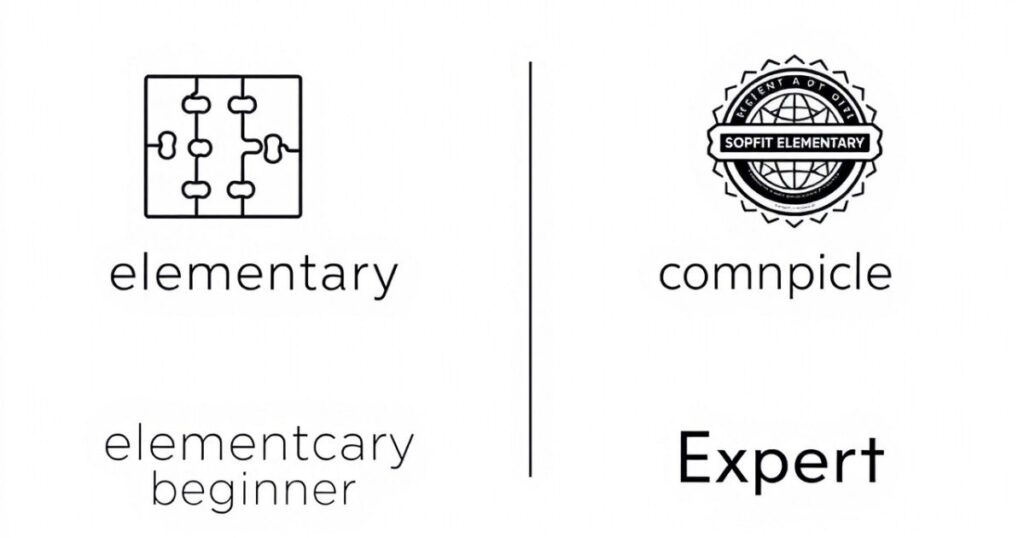Abbreviation for Elementary is useful in education. Schools, teachers, and students use it for easy writing. Instead of writing “elementary,” they shorten it. This helps in lesson plans, memos, and documents. The abbreviation for Elementary is often seen in school forms. It saves time and space. Teachers and school districts use it in official papers.
Learning the abbreviation for Elementary is simple. It improves efficiency in writing. Schools use it in academic calendars and class schedules. It helps in communication and organization. Elementary education is a key part of the educational system. Using the elementary abbreviation makes writing easier. It keeps language clear and simple. Students see it in report cards and educational materials. The abbreviation for Elementary supports clarity in language. It is important in reading and writing. Schools and teachers use it every day.
What Is the Abbreviation for Elementary?

The abbreviation for Elementary is “Elem.” Schools, teachers, and students use it in documents, lesson plans, and schedules. It helps in quick and efficient communication.
Examples:
- The school listed “Elem.” in its academic calendar.
- Teachers use “Elem.” in class schedules and report cards.
- Parents saw “Elem.” on school district memos.
- The bulletin board displayed “Elem.” for event dates.
- Educational professionals use “Elem.” in official documents.
The Origins of the Word Elementary and Its Abbreviation
The word “elementary” comes from the Latin “elementarius,” meaning basic or fundamental. The abbreviation for Elementary was created for efficiency in writing and communication.
Examples:
- “Elementarius” in Latin refers to fundamental learning.
- The word “elementary” evolved from historical language changes.
- The elementary abbreviation became common in educational systems.
- Schools started using “Elem.” for clarity in documents.
- The abbreviation for Elementary helps in shorthand writing.
Definition, Pronunciation, and Examples of “Elementary”
Elementary means basic or fundamental learning. It is pronounced “el-uh-men-tuh-ree” or “el-uh-men-tuh-ree” in US English. The abbreviation for Elementary makes writing easier.
Examples:
- The elementary abbreviation is used in school documents.
- The pronunciation of “elementary” varies slightly.
- “Elementary” is used in academic papers and report cards.
- Schools rely on the abbreviation for Elementary daily.
- “Elem.” helps in organizing schedules and forms.
Why Use Abbreviations for Elementary?
Using the abbreviation for Elementary saves time and space. It makes school communication faster. Teachers, students, and administrators use it in memos, schedules, and report cards.
Examples:
- The elementary abbreviation helps in formal and informal writing.
- “Elem.” is commonly seen in educational materials.
- School districts use “Elem.” for efficiency.
- The abbreviation for Elementary improves clarity in documents.
- Using “Elem.” reduces repetitive writing in school forms.
When and Where to Use Abbreviation for Elem.
The abbreviation for Elementary, “Elem.,” is used in schools, documents, and schedules. It helps teachers, students, and administrators communicate efficiently. Schools use “Elem.” in academic calendars, report cards, and lesson plans. The elementary abbreviation appears in memos, bulletin boards, and educational materials. It saves space in writing and keeps communication clear.
Examples:
- Schools use “Elem.” in class schedules and school district reports.
- Teachers write “Elem.” in lesson plans and event calendars.
- Parents see “Elem.” on report cards and school forms.
- Memos and bulletin boards display “Elem.” for announcements.
- The abbreviation for Elementary appears in educational documents for clarity.
Short Abbreviation for Elementary
The abbreviation for Elementary is “Elem.” It is commonly used in schools, lesson plans, and academic documents. The elementary abbreviation makes writing faster and clearer. Schools, teachers, and administrators rely on it for efficiency.
Examples:
- “Elem.” appears in school district reports and class schedules.
- Teachers write “Elem.” in educational materials and forms.
- Report cards often include “Elem.” for grade levels.
- Schools use “Elem.” in bulletins and event calendars.
- The abbreviation for Elementary simplifies communication in education.
Acronym for Elementary
Unlike abbreviations, which shorten words, acronyms use the first letters of multiple words to form a new term. While “Elementary” does not have a widely recognized acronym, creative acronyms can be used in education to represent key ideas related to learning. For example, E.L.E.M. could stand for “Education, Learning, Excellence, and Mastery,” highlighting the core principles of elementary education.
In schools, teachers and administrators may create acronyms for programs or subjects within elementary education. These help students and parents remember important concepts. However, the abbreviation for Elementary, “Elem.,” remains the most common way to shorten the word in written documents, schedules, and memos. While acronyms can be helpful in certain contexts, using the full word “Elementary” ensures clarity in professional and academic communication.
How to Pronounce “Elementary”
The word “elementary” is pronounced as “el-uh-men-tuh-ree” or “el-uh-men-tree” in US English. Both pronunciations are correct and commonly used. The abbreviation for Elementary, “Elem.,” does not change the pronunciation. Schools, teachers, and students often say “elementary” when referring to primary education.
- The teacher pronounced “elementary” as “el-uh-men-tuh-ree” in class.
- Some students say “el-uh-men-tree” as a shorter version.
- The word “elementary” is used in academic papers and school documents.
- Parents hear “elementary” during parent-teacher meetings.
- The abbreviation for Elementary does not affect its pronunciation.
Related Guide:
35 Common Idioms For Car Simplified
When Should You Use the Abbreviation?
The abbreviation for Elementary, “Elem.,” should be used in formal and educational settings where space is limited. Schools, teachers, and administrators use “Elem.” in lesson plans, class schedules, and academic calendars. It is also common in documents, memos, and school district reports. Using abbreviations helps keep communication clear and efficient.
Students and parents often see “Elem.” on report cards, event calendars, and bulletin boards. The elementary abbreviation also appears in textbooks, educational materials, and forms. It is essential to use “Elem.” when writing official documents, but in formal writing, it is better to use the full word “Elementary.”
- Schools use “Elem.” in academic documents and grade-level reports.
- Teachers write “Elem.” in lesson plans and event notices.
- The abbreviation for Elementary appears in bulletin board announcements.
- Report cards and educational forms include “Elem.” for clarity.
- School districts use “Elem.” in official school communications.
Example Sentences Using “Elementary” and Its Abbreviation
The word “elementary” is widely used in education, while “Elem.” serves as its shortened form in writing. Schools, teachers, and students frequently use the abbreviation for Elementary to make communication easier. Below are some sentences demonstrating its use in different contexts.
“Elementary” is often used in spoken language, while “Elem.” is preferred for written communication. Whether discussing foundational learning or grade levels, the elementary abbreviation ensures clarity. Here are some examples of both forms in sentences:
- My child attends elementary school in our school district.
- The academic calendar includes schedules for Elem. students.
- The abbreviation for Elementary is often used in report cards.
- Parent-teacher meetings discuss elementary education strategies.
- Schools post Elem. event schedules on bulletin boards.
Synonyms for Elementary
Synonyms for “elementary” help expand vocabulary and improve understanding. The word “elementary” refers to basic education, fundamental principles, or foundational knowledge. Many words share similar meanings and can be used interchangeably in different contexts.
The abbreviation for Elementary, “Elem.,” is often used in education, but full synonyms provide better clarity in formal writing. Teachers and students may use different words to describe elementary learning and concepts. Here are some common synonyms:
- Basic : Elementary education focuses on basic reading and writing skills.
- Fundamental : Schools provide fundamental knowledge in core subjects.
- Introductory : The class offers an introductory understanding of science.
- Primary : The primary goal of education is foundational learning.
- Rudimentary : Students develop rudimentary math skills in early grades.
Antonyms for Elementary

While “elementary” refers to fundamental or basic concepts, its antonyms describe advanced, complex, or specialized knowledge. In education, the abbreviation for Elementary, “Elem.,” represents early learning, while antonyms apply to higher education levels.
Understanding antonyms helps in academic writing and communication. Teachers, students, and writers can use precise language to contrast elementary concepts with more advanced ones. Here are some antonyms for “elementary”:
- Advanced : High school offers more advanced courses beyond elementary education.
- Complex : Some subjects require complex problem-solving skills.
- Sophisticated : College education involves sophisticated research and analysis.
- Specialized : Medical school provides specialized knowledge in healthcare.
- In-depth : University studies focus on in-depth learning and research.
The History of the Word Abbreviation for Elementary
The word “Elementary” comes from the Latin term elementarius, meaning “rudimentary” or “basic.” It has been used for centuries to describe fundamental learning and primary education. Over time, as schools and educational systems developed, the word became commonly associated with the early years of schooling. The abbreviation for Elementary, “Elem.,” emerged as a way to simplify writing in documents, memos, and school schedules.
Throughout history, abbreviations have played a key role in making communication more efficient. The use of elementary abbreviation became more common in official school records, report cards, and administrative forms. While “Elem.” is widely used in informal and written communication, the full word “Elementary” remains essential in formal writing, ensuring clarity and professionalism in education-related materials.
When Not to Use Abbreviation for Elementary
The abbreviation for Elementary, “Elem.,” is useful in informal or space-limited contexts, but there are times when using the full word “Elementary” is necessary. In formal writing, such as academic papers, official documents, and professional reports, it is better to avoid abbreviations.
Schools, teachers, and educational professionals should use “Elementary” in legal documents, research papers, and school policies. When communicating with parents or the public, writing the full word ensures clarity. The elementary abbreviation is helpful for internal communication but should be avoided in formal presentations and reports.
- Use “Elementary” in official school district policies.
- Avoid “Elem.” in formal writing or academic research.
- “Elementary” should be used in legal documents and contracts.
- Teachers should spell out “Elementary” in professional reports.
- Avoid abbreviations in educational publications and books.
Example of the Word and Abbreviation in Context
The word “Elementary” and its abbreviation for Elementary, “Elem.,” appear in various contexts. While the full word is often used in speech and formal writing, the abbreviation is common in schedules, memos, and internal documents.
Below are examples of how both forms are used in different sentences. The elementary abbreviation is typically seen in written materials where space is limited, while “Elementary” is preferred in complete sentences.
- My son is in Elementary school, learning basic subjects.
- The school district updated the Elem. academic calendar.
- Parent-teacher meetings for Elementary students are scheduled monthly.
- The report card listed “Grade 3 : Elem.” under the student’s school level.
- Teachers prepared lesson plans for their Elementary classes this week.
Personal Reflection: The Power of Abbreviations

Abbreviations make communication faster and more efficient. In everyday life, we use them without even thinking whether it’s writing “Elem.” for Elementary, “Dr.” for Doctor, or “etc.” for etcetera. These shortcuts save time and space, especially in education, where schedules, lesson plans, and reports rely on clear and quick communication. The elementary abbreviation is just one example of how language adapts to our needs, making information more accessible.
However, while abbreviations help with convenience, they also have limits. Overusing them can lead to confusion, especially in formal writing or when clarity is essential. It’s important to know when to use the full word and when an abbreviation is appropriate. Understanding this balance ensures effective communication, whether in education, business, or everyday conversations. The abbreviation for Elementary is useful, but knowing when to spell out “Elementary” helps maintain professionalism and clarity.
FAQ’s
What is the Abbreviation for Elementary?
The common abbreviation to Elementary is “Elem.” Schools and teachers use it in lesson plans, academic calendars, and educational materials.
Why is the Abbreviation for Elementary used?
It saves time and space in documents, forms, and memos. The abbreviation to Elementary helps in efficient communication within the educational system.
Where do we see the Abbreviation for Elementary?
You can find it in school district papers, report cards, and bulletin boards. The abbreviation to Elementary is also used in class schedules.
Is the Abbreviation for Elementary different in formal writing?
Yes, formal writing usually avoids abbreviations. However, the abbreviation to Elementary is common in casual school documents and quick notes.
Who uses the Abbreviation for Elementary?
Teachers, students, and school administrators use it daily. The abbreviation to Elementary is important for clarity and organization in education.
Conclusion
The abbreviation for Elementary is useful in schools. It makes writing faster and easier. Teachers and students see it in lesson plans, documents, and report cards. The abbreviation for Elementary helps in organizing educational materials. Schools use it in memos, class schedules, and academic calendars. It improves communication and saves time. Using the elementary abbreviation keeps writing clear and simple. It is important in the educational system.
Learning the abbreviation for Elementary is helpful for students and teachers. It is often used in school districts and bulletin boards. The elementary abbreviation makes reading and writing more efficient. It is part of foundational learning. Understanding it improves clarity in language. Schools, parents, and educators rely on it daily. The abbreviation for Elementary is a small but important part of education. It supports learning processes and organization. Every student should know the elementary abbreviation for better communication.

Atlas Reid is an experienced administrator with 5 years of expertise in managing operations, streamlining processes, and ensuring efficiency. Skilled in leadership, organization, and problem-solving to drive business success.








